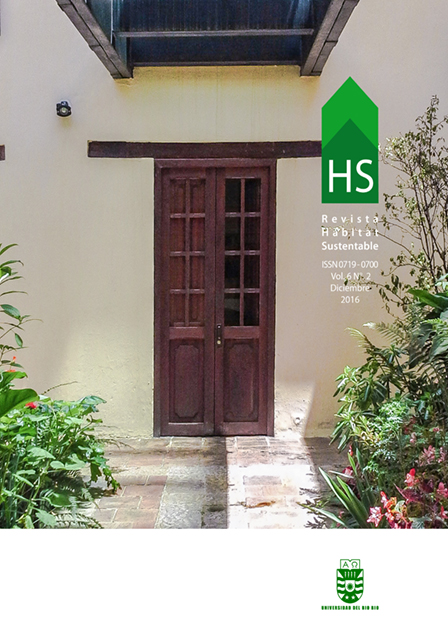An estimate of overheating risk and cooling potential using natural ventilation in single-family dwellings in coastal chilean cities
Keywords:
ventilation, cooling, housesAbstract
This article presents a proposal to evaluate cooling demand and passive cooling capacity using natural ventilation in social housing. The proposal is founded on EN ISO 13790:2008, which uses a semi- dynamic calculation method. The dwellings evaluated have double casement windows in the two main facades, which are oriented N-S, E-W, NW-SE and NE-SW. Two possible internal distributions were tested: poorly-connected and well-connected. The locations evaluated have a variety of climates: from the northern deserts to the weather of central and southern Chile with more defined seasonal variability. The cities included in the study are: Arica, Iquique, Antofagasta, La Serena, Valparaíso, Concepción, Valdivia and Puerto Montt. The results show that cooling demand is present in the majority of the locations analyzed and the average capacity for heat evacuation by natural ventilation is between 20% and 80% of this demand, thereby demonstrating the usefulness of breezes for building and city cooling in Chile.
Downloads
References
BUSTAMANTE, Waldo, DE HERDE, André, ENCINAS, Felipe. Analysis of office building thermal performance in different districts of the Metropolitan Area, Chile. Revista de la Construcción, vol. 10, (no 1): pp. 64-77,April 2011.
EDWARD,ng. Policies and technical guidelines for urban planning of high- density cities – air ventilation assessment (AVA) of Hong Kong. Building and Environment , vol. 44, (no 7), p. 1478-1488.July 2009.
KOLOKOTRONI, Maria, GIANNITSTARIS, Ioannis, WATKINS, Richard. The effect of the London urban heat island on building summer cooling demand and night ventilation strategies. Solar Energy, vol. 80, (no 4): pp. 383-392, April 2006.
GALDERISI, Anna, MAZZEO, Giuseppe, PINTO, Fulvia. Cities Dealing with Energy Issues and Climate-Related Impacts: Approaches, Strategies and Tools for a Sustainable Urban Development. En: Smart Energy in the Smart City. Urban Planning for a Sustainable Future. Springer Ed. 2016, pp.199- 217
GHIAUS, Christian, ALLARD, Francis, SANTAMOURIS, Matheos, GEORGIAKIS, Constatinus, NICOL, Fergus. Urban environment influence on natural ventilation potential. Building and Environment 2006, vol. 4, (no 1): p. 395-406.2006.
GROSSO, Mario. Il raffrescamento passivo degli edifici. Maggioli Ed. Milano 2011
HOLMES, Michael, HACKER, Jacob. Climate change, thermal comfort and energy: Meeting the design challenges of the 21th Century, Energy and Buildings 2007, vol. 39, (n° 7): p. 802-814.2007.
HEISLEBERG, Per, SANDBERG, Mats. Evaluation of Discharge Coefficients for Window Openings in Wind Driven Natural Ventilation. International Journal of Ventilation, vol.5, (no 1): pp. 43-52.March 2016.
ISO 13790/2008 (rev. 2012) Energy performance of buildings - Calculation of energy use for space heating and cooling.
LEBASSI-HABTEZION, Bereket, GONZÁLEZ, Jorge, BORNSTEIN, Robert. Modeled large-scale warming impacts on summer California coastal cooling trends. Journal of Geophysical Research, vol. 116, (no D20): pp. 1-11, 2011.
LI, Haiquin. KANAMITSU Masao, HONG, Song-You, YOSHIMURA, Kei, CAYAN, Daniel, MISRA, Vasubandhu, SUN, Liquiang. Proyected climate change scenario over California by a regional ocean-atmosphere coupled model system. Cimatic Change, vol.122,( no 4): pp. 609-619, december 2013.
MINVU, Manual de aplicación de la reglamentación térmica.[en línea], 2008. Disponible en:
MCLEOD, Robert. HOPFE, Cristina, KWAN, Alan. An investigation into future performance and overheating risks in passive house dwellings. Building and Environment, (no 70), p. 189-209.2013
OLIVEIRA, Marta, CAMELO, Susana, GONÇALVES, Helder. Assessment of the Portugese building thermal code: Newly revised requirements for cooling energy needs used to prevent the overheating of buildings in the summer. Energy, vol. 36, (no 5): p. 3262-3271, May 2011.
PALME, Massimo. Energy certification process in Chile: steps to dynamic simulation of buildings’ energy performance. En: Proceedings of the Passive and Low Energy Architecture Conference, (Amehdabad, India, December 2014).
PALME, Massimo. The possible shift between heating and cooling demand of buildings under climate change conditions: are some of the mitigation policies wrongly understood? En: Mediterranean Green Buildings and Renewable Energy. Springer Ed. In press
PALME, Massimo, VÁSQUEZ, Amanda. Energy labeling of residential buildings in Chile: comparing steady-state evaluations and dynamical simulation results. En: Proceedings of the Building Simulation Conference, (Hyderabad, India, December 2015).
PALME, Massimo, ISALGUÉ, Antonio, COCH, Helena, SERRA, Rafael. Energy consumption and robustness of buildings. En : Proceedings of the Central Europe towards Sustainable Buildings Conference,( Praga, República Checa, June 2010).
SANTAMOURIS, Matheos, WOUTERS, Peter. Building Ventilaton: The State of Art., USA.Earthscan, 2006
SANTAMOURIS, Matheos, CARTALIS, Constantinos, SYNNEFA, Afroditi, KOLOKOTSA, Dania. On the impact of urban heat island and global warming on the power demand and electricity consumption of buildings – a review. Energy and Buildings , vol. 98, :pp. 119-124 ,2015.
TOLEDO, Linda, CROPPER, Paul, WRIGHT, Andrew. Unintended consequences of sustainable architecture: Evaluating overheating risks in new dwellings. En: Proceedings of the Passive and Low Energy Architecture Conference, Los Angeles, USA, July 2016.
Downloads
Published
How to Cite
Issue
Section
License
The content of articles which are published in each edition of Habitat Sustentable, is the exclusive responsibility of the author(s) and does not necessarily represent the thinking or compromise the opinion of University of the Bio-Bio.
The author(s) conserve their copyright and guarantee to the journal, the right of first publication of their work. This will simultaneously be subject to the Creative Commons Recognition License CC BY-SA, which allows others to share-copy, transform or create new materials from this work for non-commercial purposes, as long as they recognize authorship and the first publication in this journal, and its new creations are under a license with the same terms.











 Scientific Information Program/Concurso Fondos de Publicación de Revistas Científicas 2018/ Proyecto Mejoramiento de Visibilidad de Revistas UBB (Código:FP180007).
Scientific Information Program/Concurso Fondos de Publicación de Revistas Científicas 2018/ Proyecto Mejoramiento de Visibilidad de Revistas UBB (Código:FP180007).





